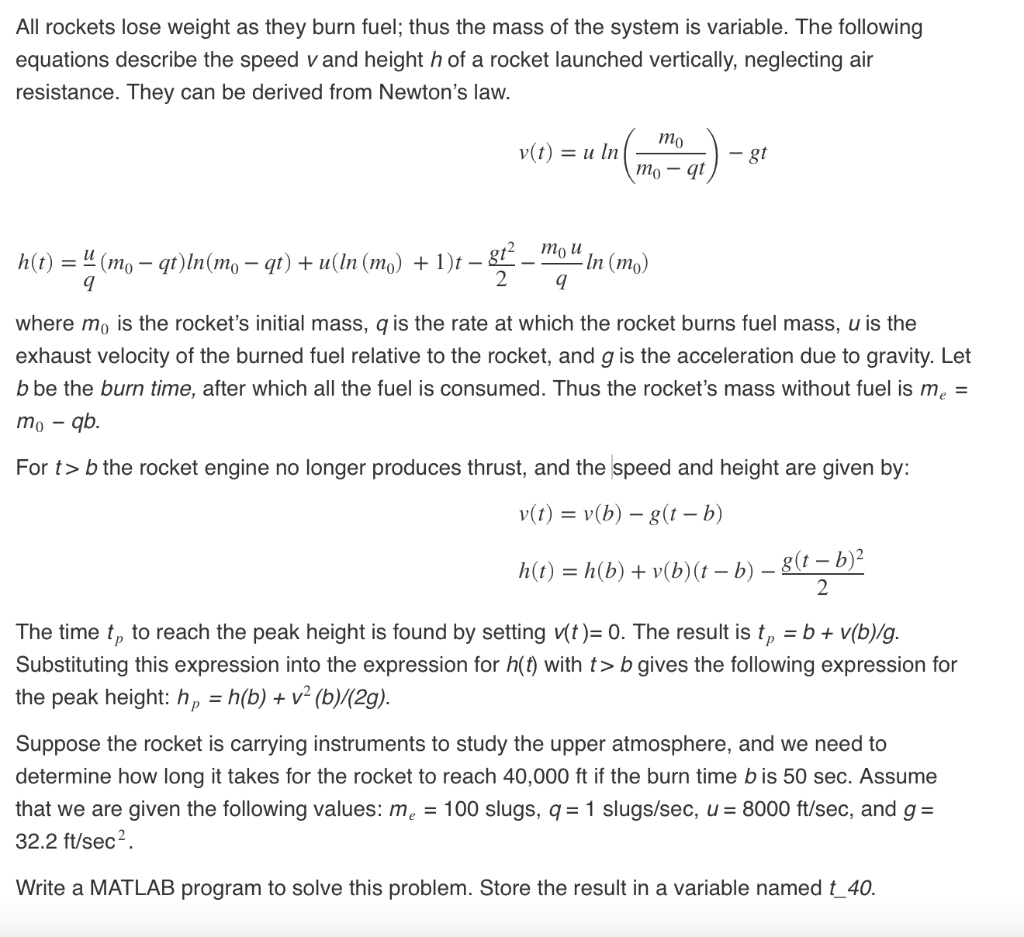
All rockets lose weight as they burn fuel; thus the mass of the system is variable. The following equations describe the speed v and height h of a rocket launched vertically, neglecting air resistance. They can be derived from Newton's law. v(t) = u In - gt mo - 91 h(t) = (mo qt)ln(mo qt) + u(In (mo) + 1)t 912 _ mo u In (mo) 9 2 9. where mo is the rocket's initial mass, q is the rate at which the rocket burns fuel mass, u is the exhaust velocity of the burned fuel relative to the rocket, and g is the acceleration due to gravity. Let b be the burn time, after which all the fuel is consumed. Thus the rocket's mass without fuel is me = mo - qb. For t> b the rocket engine no longer produces thrust, and the speed and height are given by: v(t) = v(b) g(t - b) h(t) = h(b) + v(b)(t b) 8(t b)2 2 The time t, to reach the peak height is found by setting v(t)= 0. The result is tp = b + v(b)/g. Substituting this expression into the expression for h(t) with t> b gives the following expression for the peak height: hp = h(b) + v2 (b)/(29). Suppose the rocket is carrying instruments to study the upper atmosphere, and we need to determine how long it takes for the rocket to reach 40,000 ft if the burn time bis 50 sec. Assume that we are given the following values: me = 100 slugs, q = 1 slugs/sec, u = 8000 ft/sec, and g = 32.2 ft/sec2. Write a MATLAB program to solve this problem. Store the result in a variable named t_40. All rockets lose weight as they burn fuel; thus the mass of the system is variable. The following equations describe the speed v and height h of a rocket launched vertically, neglecting air resistance. They can be derived from Newton's law. v(t) = u In - gt mo - 91 h(t) = (mo qt)ln(mo qt) + u(In (mo) + 1)t 912 _ mo u In (mo) 9 2 9. where mo is the rocket's initial mass, q is the rate at which the rocket burns fuel mass, u is the exhaust velocity of the burned fuel relative to the rocket, and g is the acceleration due to gravity. Let b be the burn time, after which all the fuel is consumed. Thus the rocket's mass without fuel is me = mo - qb. For t> b the rocket engine no longer produces thrust, and the speed and height are given by: v(t) = v(b) g(t - b) h(t) = h(b) + v(b)(t b) 8(t b)2 2 The time t, to reach the peak height is found by setting v(t)= 0. The result is tp = b + v(b)/g. Substituting this expression into the expression for h(t) with t> b gives the following expression for the peak height: hp = h(b) + v2 (b)/(29). Suppose the rocket is carrying instruments to study the upper atmosphere, and we need to determine how long it takes for the rocket to reach 40,000 ft if the burn time bis 50 sec. Assume that we are given the following values: me = 100 slugs, q = 1 slugs/sec, u = 8000 ft/sec, and g = 32.2 ft/sec2. Write a MATLAB program to solve this problem. Store the result in a variable named t_40







